
April 21st 2008
A few days ago I put the first chapter of Ice Yearning, a novel, online. This is an experiment to see whether I can make money off writing without having to criminalise people who share the work with their friends. So, if you're interested, please take a look. Actually, please take a look even if you aren't interested, because you might be surprised.
I'm doing a diary entry because we went on a little family trip yesterday. A month or so ago I bought a bunch of guidebooks for the area around Tokyo, focusing on ones that provided suggestions for walks. As Mayuki gets bigger, and we get more used to the routine of having a child in the family, I decided that I wanted us to go on family outings fairly frequently, and, fortunately, Yuriko agreed. We did ask Mayuki, but she didn't contribute anything useful to the discussion. Yesterday was the first chance we had to put that plan into practice.
We went to the Yamate (three syllables, Ya-ma-te) and Motomachi areas of Yokohama. This is fairly close to home, which was one reason for choosing it for the first trip; we can probably go a bit further in a day, but it's best to start small. Mayuki's presence makes the logistics a bit more complex. Most notably, I was carrying her, in a carrying harness, all day. Since we left the house just after 10am, and got back just after 8pm, I suppose I shouldn't be surprised that I woke up with slightly sore shoulders and back today. The fact that they were only slightly sore, and are pretty much OK now, just after lunch, is a good sign; it suggests that this really is a practical scheme, at least for now. If we do it often enough, I might naturally put on muscle as Mayuki puts on weight, at least until she can walk for herself.
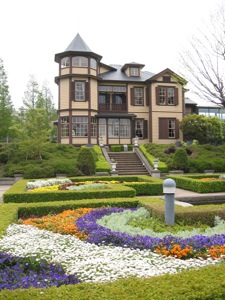 A diplomat's house, rebuilt in Yokohama.
A diplomat's house, rebuilt in Yokohama.
The Yamate area of Yokohama is notable because it was one of the first areas in the country where foreigners were allowed to live in modern times. From the early seventeenth century until the middle of the nineteenth, Japan was officially closed to all contact with the outside world, and even in practice contacts were quite limited. This annoyed the Americans, who wanted to refuel their whaling vessels there, so they sent a small naval squadron to demand that Japan open up, or be invaded. This basically terrified the Japanese, because they'd been at peace for 250 years, and ignoring the development of military technology; some people wanted to repel the foreign barbarians, but those who had actually taken a look at the military power of the foreign barbarians realised that Japan would be crushed, and they won the argument; Japan opened up.
However, they only did it slowly. There were a small number of specified ports, including Yokohama, where foreigners were allowed to settle and trade freely. The area of Yokohama set aside for their residences was Yamate. Naturally, many of the foreigners (which, in this context, means Europeans and Americans) built themselves European style houses. Some of those houses still survive today.
Naturally, this gives the area a rather different feel to other areas of Japan. In particular, it has a more western feel, which is probably why it does not feature on suggested tourist itineraries for foreigners; you can see similar buildings back home, after all. The guide book has a suggested walking route, which we followed, and which seemed quite good; the first place it took us was the "Yamate Italy Mountain Garden". Italy Mountain, I think, is the place where the Italians had their diplomatic buildings, although they've all gone. The house we looked round, in the picture, was built by a Japanese diplomat who had served in the USA, in American Victorian style. It was also built in Shibuya, and moved to Yokohama about ten years ago, being carefully restored in the process. The interior was also restored, with furniture, to look as it would have done in the early twentieth century.
It was really rather strange. It felt just like a Western home of that sort of period. They really did a pretty good job of copying our architectural styles.
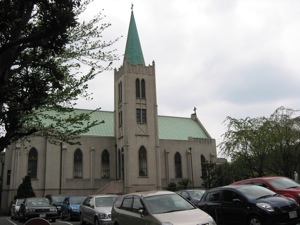 Yamate Catholic Cathedral
Yamate Catholic Cathedral
From there, we walked along Yamate Main Street, which is lined with very individual, and western-style, houses, although it looks as though most people in the area now are Japanese. One thing that did stand out, however, was the number of churches. The first one we came to was the Catholic cathedral, which was, apparently, founded in 1862, as the first church to be founded in Japan after the country was opened. The current building is the second, because the area was badly hit by the Great Kanto Earthquake and Second World War; this is one reason why so few of the original buildings survive. We also passed a Mormon church, what I think was an Anglican church (it certainly looked like one), a sign to a Seventh Day Adventist church, and a non-denominational church. We didn't see many shrines or temples in the area.
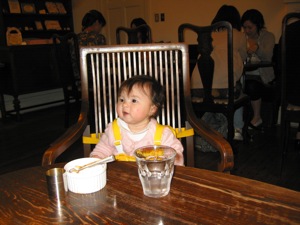 Mayuki sitting at the table at lunch.
Mayuki sitting at the table at lunch.
The road brought us to another cluster of western-style buildings, and we looked round a couple, and had lunch in a third. This was a cafe recommended in our guidebook, and although their main business was selling cakes, they also did sandwiches and hamburgers. I had a sandwich, and Yuriko had a hamburger. Both were really, really good. I had croque monsieur, and both the ham and cheese were tasty, and it was nicely seasoned with salt and pepper. The cakes we had afterwards were very good as well, but the guidebook recommended those, so I wasn't surprised. The cafe is called Enokitei, and I recommend it as well.
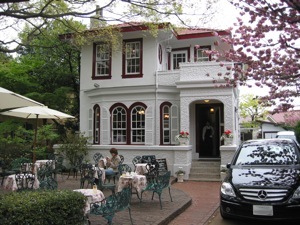 Enokitei, where we had lunch, from the outside.
Enokitei, where we had lunch, from the outside.
In keeping with the area, all the food was western-style, and so was the decor. In fact, it could have been a coffee shop or cafe in a tourist area of Britain, except that the food was better. (The prices are about what you'd expect in a British tourist trap, but the food was actually about worth it. Given its convenience, I have no complaints on that score.) In the cafe, we had the chance to try something that Yuriko bought on Saturday: a belt for fastening babies into ordinary chairs, so that they can sit with you in restaurants. You can see it in the picture of Mayuki; it's the bright yellow thing. It worked very well, and both Yuriko and I were able to enjoy lunch in a civilised fashiong.
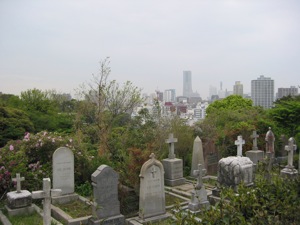 The Yokohama Foreigners' Cemetery, with Minato Mirai Landmark Tower in the background.
The Yokohama Foreigners' Cemetery, with Minato Mirai Landmark Tower in the background.
After lunch, we walked on to the Yokohama Foreigners' Cemetery. This is probably the oldest cemetery for foreigners in Japan; the first person interred there was an officer on the American ships that came to open the country up. It's still in use today, and it's very interesting. In a lot of ways, it's reminiscent of a British graveyard with a history going back to the nineteenth century, but because it was for all the foreigners in Yokohama it also has graves in French and German, and Russian graves with crosses in the shape favoured in the Orthodox Church, with three bars crossing the upright. There were quite a lot of "[Foreign Name] and his beloved wife [Japanese Name]" graves, so I'm clearly following in a well-established tradition.
One thing was rather odd. On a number of gravestones there were names carved, with birth dates, but with no death dates. I'm assuming that this is because the people in question haven't died yet. This is something I don't recall ever seeing in Britain. Another interesting monument was the one to the dead of the First World War; British, French, and American. The soldiers named there had been despatched from Yokohama to the front, so that's another reminder that Japan was on our side in WWI, something that seems to get forgotten.
 In "Hill Where You Can See The Port" Park, with Yokohama Bay Bridge in the background.
In "Hill Where You Can See The Port" Park, with Yokohama Bay Bridge in the background.
From the graveyard, we went on to "Hill Where You Can See The Port" Park. This is a very accurate name. There is a park, on a hill, and from the hill you can see Yokohama port. It's a nice view. Mayuki really seemed to like it; she was squealing with excitement most of the time we were up there, particularly when Yuriko was taking photographs. It does mean that we got some nice pictures of her, and suggests that she also enjoyed the trip.
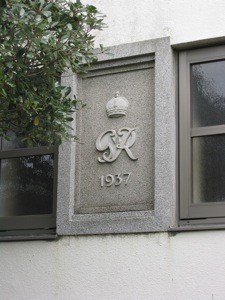 Not a common sight in Japan.
Not a common sight in Japan.
The park is on the sites of the former British and French consulates. The British consulate building survives, and is now owned by the city of Yokohama. It is part museum, part event location, and called the "England Hall". Naturally, we had to go and look at it. Unlike a lot of the western-style buildings in the area, it was made of concrete, and, as you can see from the panel on the side, it was built quite late. It's odd to remember that in 1937 the British were building a new consular residence in Japan.
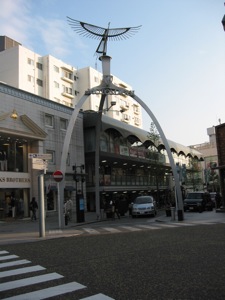 One of the entrances to Motomachi.
One of the entrances to Motomachi.
From the park, the final bit of the walk took us to Motomachi. This is a shopping street, apparently one of the fashion centres of Japan. The large metal structures at both ends of the road suggest that it's quite prosperous, as do the shops lining it. It was already getting quite late, so we didn't have time to do any shopping, but we did have dinner at a tonkatsu (pork cutlet) restaurant. It was very nice; I had the garlic tonkatsu, and they certainly won't face any problems with trade description legislation. The only problem was that it was sofa-style seating, so we couldn't strap Mayuki in. This meant that we had to eat while holding her, and swap her between us from time to time during the meal, so that we could both finish.
The whole day was very enjoyable, so we'll have to do more such trips. I'm hoping that we'll be able to fit one in next month, possibly to somewhere slightly more Japanese.